

Warm Tip: If you want to know more details about equipment, solutions, etc, please click the button below for free consultation, or leave your requirements!

Now, common classifiers in mineral processing plant are mainly mechanical classifier and hydrocyclone. Among them, mechanical classifier can be divided into spiral classifier, rake classifier, tank classifier and other types. With the development of classification operation, rake classifier is already replaced by spiral classifier for complicated structure and weak classification effect. Tank classifier is gradually replaced by hydrocyclone for large place occupied and low classification efficiency. Although the rapid development of hydrocyclone let classifier lose its importance, with the change of mineral processing plant requirement, people found that spiral classifiers have their advantages:
Sand return automatically lifts to a certain height and then directly returns to the feeding end of the ball mill, eliminating the need for joint feeder and greatly saving equipment and civil construction investment.
The continuity and stability of sand return and the high concentration of sand return are beneficial to the improvement of grinding concentration and grinding efficiency.
The graded particle size can be controlled according to different feeding amount and overflow concentration.
Simple structure, easy to operate and manage, and reliable operation and low maintenance costs
So, what are the common types of spiral classifier? How can we distinguish and choose the suitable spiral classifier?
According to the height of overflow dam, that is the relative position of spiral in tank and slurry surface, spiral classifier can be divided into high dam spiral classifier, low dam spiral classifier, and submerged spiral classifier.
In high dam spiral classifier, the position of overflow dam is usually higher than the bearing center at the lower end of the spiral shaft and lower than the upper edge of the spiral at the overflow end. The height of dam can also be adjusted within a certain range, that is, the area of settlement area can be slightly changed according to the grading requirements, so as to adjust the grading particle size.
The overflow dam of the low dam type spiral classifier is usually lower than the center of the bearing at the overflow end. Therefore, the settlement area is too small and the overflow production capacity is too low, and the screw agitation on the pulp surface is too large. Therefore, it is only used in the actual production to wash the sand and coarse particles with less mud, and it is rarely used in the ore grinding grading operation.
The overflow end of submersible spiral classifier is usually equipped with 4-5 spiral blades, all of which are immersed under the liquid level in the settling area, so the settling area is large and the grading pool is deep.
There are differences in structure between high dam spiral classifier and submerged spiral classifier, so they are different in classification application. The high dam classifier is more suitable for the coarse classification and the first classification with minerals grain size over 0.15mm. Due to its stable grading surface, high overflow yield and fine particle size, the submerged spiral classifier are more suitable for separating overflow products with particle size less than 0.15mm. It is often combined with the grinding mechanism in the second section of the mill.
According to the number of screw shift, the spiral classifier can be divided into single spiral classifier and double spiral classifier. The grading performance of the two is basically the same, but the double helix classifier in return sand treatment capacity, overflow treatment capacity, the same specification of screw diameter is significantly larger than the single helix classifier, and the price of the double helix classifier is far higher than the single helix classifier, so it is more suitable for the use of large grinding machine.
Mineral processing experts suggest that the single screw classifier should be selected as far as possible under the determined processing capacity. According to statistics, the working load of the double screw classifier is 0.6-0.75 times that of the single screw classifier, and the efficiency is relatively low. Therefore, when selecting the screw classifier, the appropriate screw speed and number must be determined according to the processing capacity.
All types of classified equipment mentioned above have their own advantages and have different effects on the efficiency of classified equipment. According to the current different classification requirements, different types of classification equipment have been optimized and improved to achieve a good classification effect. When selecting grading equipment, each selecting plant must clearly grasp its type characteristics and working principle, and consider the ideal process flow and equipment according to its own selecting plant production demand.
1What Should You Know Before Choosing Spiral Classifier?
 -926
-926
 2967
2967
2Application of Hydrocyclone in Gold Ore Tailings
 0
0
 5183
5183
3Development of Hydrocyclone
 2
2
 3829
3829


What Are the Differences Between CIP and CIL?
 11382
11382
 0
0